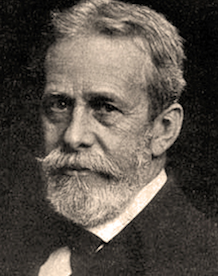By Andrew Huff
According to Anna Knipp and Thaddeus Thomas’ The History of Goucher College (1938), the institution’s namesake, John Franklin Goucher (ΦBK, Dickinson College, 1868) lived by a benevolent personal mantra: “Whatever you ask, I’ll do it with greatest pleasure.” His altruism led him to receive a Doctor of Divinity in 1885 and a Doctor of Laws in 1889 from Dickinson College, after which he joined the Baltimore Conference of Methodist Episcopal ministers.
A firm commitment to education complemented Goucher’s ministerial calling. He believed that good scholarship endows the individual with a more meaningful interaction with the world; and, though devout, Goucher also held as truth that “evangelism without education faces fanaticism” (The History of Goucher College). He sought to curtail this latter possibility by joining the Board of Foreign Missions of the Methodist Episcopal Church to aid with international education.
Knipp and Thomas note two special moments of recognition for Goucher. First, on November 12, 1919, in response to Goucher’s missionary service, the Emperor of Japan granted him the highest honor that the Japanese government could give to a civilian: the insignia of the third degree of the Order of the Rising Sun. Then, on March 5, 1921, the President of China awarded Goucher the insignia of the third degree of the Order of Chia Ho, an equally prestigious award.
Though his accolades inspire awe, it is Goucher’s sojourn to Egypt in 1895 that underpins a rich piece of Baltimore lore. The Ptolemaic period (305-30 BCE) mummy he acquired while abroad has become a token of his penchant for Egyptology and a testament to his subtler legacy: enduring scholarly curiosity. The winding journey of the “Goucher Mummy” throughout Baltimore over the past century has also further intertwined two of the city’s academic institutions, Johns Hopkins University and Goucher College.
The Baltimore Sun reported in 1895 that, four years after beginning his service as president of the Baltimore Woman’s College, Goucher concluded his trip to Egypt with the acquisition of multiple mummies (“Unwrapping A Mummy: One of two secured in Egypt for the Woman’s College”). On August 16 that year, The American Newspaper reported that he attempted, unsuccessfully, to unwrap one of the mummies at the college alongside an audience of academics and reporters (“A Cut Into the Mummy”).
According to the Archeological Museum at Johns Hopkins University (which currently holds the mummy in question), it lingered on display at the college following its initial examination. In 1922, upon the death of Goucher, the Board of Trustees of the Baltimore Woman’s College voted to rename the institution “Goucher College” (The History of Goucher College). Then, in 1938, they agreed to loan the late-president’s mummy to the Baltimore Museum of Art.
The mummy returned to Goucher College in 1971 where, as The Goucher Quarterly noted in 1988, it resided discreetly in an old art storage room and then the underside of a library table (“Mummy Meets Computer”).
In 1988, though, the quiet soon dissipated. The Archeological Museum at Johns Hopkins University reports that the museum’s director, Betsy Bryan, brought the mummy from the Goucher library to the university’s hospital for examination (“The Goucher Mummy”). According to the Baltimore Morning Sun, medical experts used CT scans and x-radiography to determine the age, gender, and general health of the mummy; the event created a sensation as the first mummy scan conducted by the hospital (“Hopkins Does Its First-Ever ‘Mummy Scan’”).
The Archeological Museum’s profile of the examination indicates that the mummy, who had been nicknamed “Boris,” was actually a woman who lived between 45-50 years and who had likely given birth to two children (“The Goucher Mummy”). They also confirmed that, in accordance with Egyptian funeral rites, her brain and other internal organs had been removed from the body, wrapped, and then placed back in it.
Though it serves most directly as a reminder of ancient Egypt, the mummy has also become a token of the liberal arts. A quick glance across the mummy’s informational plaque conjures the union of medical, historical, and archeological sciences that together unraveled its identity. Through interdisciplinary inquiry, the investigation into this quirky heirloom begun by Goucher finally came to a conclusion.
Andrew Huff is a senior at Goucher College majoring in Political Science. Goucher College is home to the Beta of the Maryland Chapter of Phi Beta Kappa.
Photo at top, John Franklin Goucher, circa 1908.




